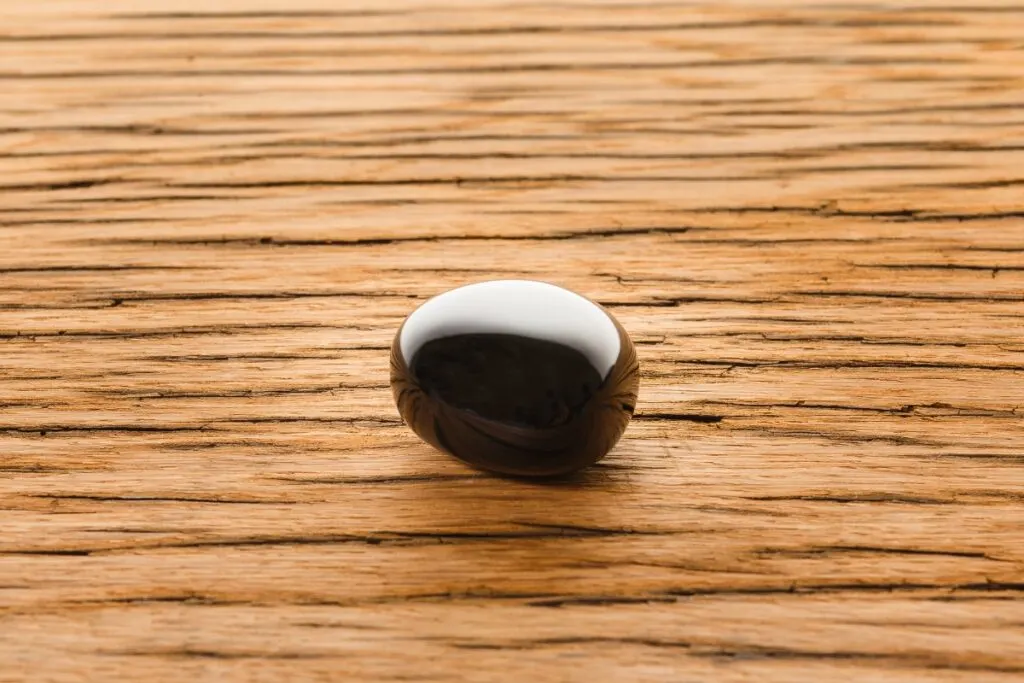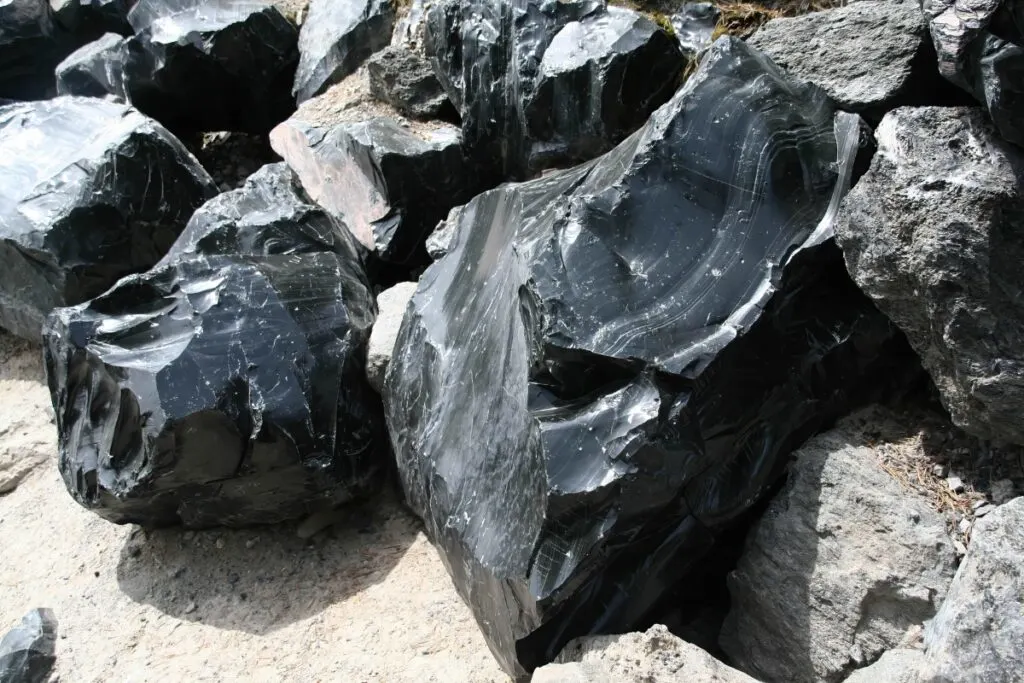As an Amazon Associate, I earn from qualifying purchases with no additional costs for you.
Obsidian fakes are hardly spotted with the unaided eye. Time, patience, and additional equipment are needed to differentiate between natural and fake obsidian. Obsidian is a readily available gemstone because of numerous geological sources from all over the world. Still, even this fact doesn’t stop fake gemstone manufacturers.
Real and fake obsidian can be set apart by 8 key factors: color, texture, density, hardness, translucency, a form of bubbles, hot needle and UV light reaction, and form of occurrence. Real obsidian is dark colored, translucent to opaque, dense, and inert to UV light material that never forms crystals.
Dragonglass from the Game of Thrones TV show is obsidian! Characters highly prized this stone because of its properties, so let’s learn more about it! Real obsidian is a natural glass.
That is why it is really challenging to differentiate one glass from another, as they have similar hardness and fracture type – features commonly used in fast mineral identification. No worries, this article will pay attention to other helpful properties that separate real and fake obsidian.

If you are interested in checking out the best books about rock and minerals identification you can find them by clicking here (Amazon link).
How to Tell if Obsidian Stone is Real
Real obsidian is commonly known as a black-colored, translucent, or opaque stone with very sharp edges and characteristic conchoidal (shell-like) fracture. Obsidian was known to ancient people as a hard, sharp, and durable material and used as knife blades, arrows- and spearheads.
To tell if an obsidian stone is real, check the intensity of color and translucency and examine the stone attentively under magnification. Next, observe the characteristics of texture and gas bubble inclusions. Finally, check the sample with a hot needle to exclude substituents made of plastic.
Obsidian’s distinguishing features are confined to its geological formation process. Obsidian is a natural glass that formed as a result of rapid lava solidification on the surface. Obsidian usually has rhyolitic composition. It is composed of more than 70 percent silica and is low in volatile content.
Formation on the surface led to air bubbles trapped in obsidian during solidification. The bubbles can be of elongated forms that follow the direction of lava flows.
Obsidian is neither a rock nor a mineral. It is considered to be a mineraloid as it has no crystalline structure. It cannot be classified as a rock as there is an almost total absence of sizable mineral crystals within the glass matrix. Because of rapid solidification, crystals have no time to grow in a lava flow.
Even being composed of silica mostly, obsidian is softer than quartz and any of its varieties. Obsidian typical hardness of 5 to 5.5 on the mineral hardness scale.
In contrast, quartz (crystallized silicon dioxide) has a hardness of 7.0. This feature allows distinguishing real obsidian from quartz, chalcedony, and their numerous varieties.
BTW: Do you want to know more about rock and mineral identification? The books listed below are the best ones you can find on the internet (Amazon links):
- Smithsonian Handbooks: Rocks & Minerals
- Gemstone & Crystal Properties (Quick Study Home)
- Ultimate Explorer Field Guide: Rocks and Minerals (National Geographic Kids)
What Does Real Obsidian Stone Look Like
Real obsidian generally looks dark (black, brown, dark green, and dark blue colors). It is opaque or translucent means it doesn’t transmit light through. Textures of real obsidian are naturally uneven. Bubbles in real obsidian look elongated and generally follow the same direction.
Can Obsidian be Faked?
Even being a readily available material, obsidian can still be faked. Obsidian fakes are represented mainly by glass and plastic because glass has very similar physical properties to real obsidian. Plastic, in turn, is a good imitation of textures, especially for snowflake obsidian.
What Can be Mistaken for Obsidian
The most common unnatural obsidian substituents are glass and plastic. However, natural materials like black onyx, jet, jasper, and morion (black quartz) can sometimes be mistaken for obsidian. All of them have typical characteristics that can help differentiate them from real obsidian.
How to Spot Fake Obsidian Stone
Distinguishing between fake and natural obsidian is very challenging. The main reason is that the most common obsidian fake is glass. Natural obsidian is also glass but created by nature.
That is why it is very complicated to set apart two types of glasses. Even for gem professionals, it is hard to tell apart fake and real obsidian without any additional gemological tools.
To spot fake obsidian, check the saturation of color. It should not be bright, translucency (fakes will be transparent), hardness (hardness of fakes is lower), and density (real obsidian feels harder and denser). The texture of fakes is too even and smooth. Fakes can be molten by a hot needle and glow under UV.
TIP: The real obsidian is a naturally occurring volcanic glass. And some of the real obsidian varieties can be quite expensive. Find out more about the value of obsidian in the article below:
5 Crucial Factors of Obsidian Value: What’s Obsidian Worth?
Main Differences Between Real and Fake Obsidian

The main difference between real and fake obsidian is color and translucency. Real obsidian will newer be bright colored and perfectly translucent.
Also, because of specific geological formations, real obsidian will have elongated gas bubbles, while fake has rouned once. Additional hot needle and UV test let spot plastic fakes.
| Characteristic property | Real obsidian | Fake obsidian |
|---|---|---|
| Hardness | 5.5 on the Mohs scale. Real obsidian can be scratched by a knife and a piece of glass. Scratch is uneven, and the out-of-scratch material of real obsidian is white and chalk-like. | Fake obsidian made of plastics can be scratched by a knife and a piece of glass. The scratch is even, and the out-of-scratch material doesn’t break apart. |
| Bubbles’ appearance under magnification | All bubbles have an elongated appearance in one direction, indicating lava flow. | Bubbles in man-made glass are commonly round. |
| Density | Real obsidian feels heavier and denser in comparison with man-made glasses. | Feels light and less dense than natural stone. |
| Color | The colors of real obsidian are dark and dull. However, they are never too vividly saturated and have an admixture of brownish and grayish stains. | The colors of fake obsidian can be vivid blue, bright green, and intense red without any admixture of gray and brown hues. |
| Translucency | Real obsidian is commonly opaque and translucent. | Transparent stones are a sign of fake obsidian. |
| Texture | Natural obsidian has never even repetitive textures. | Fake snowflake obsidian can be spotted due to repetitive textures. |
| Glow under UV light | Real obsidian is inert and doesn’t glow under UV. | Artificial glasses and translucent plastics can glow under UV in chalky-bluish colors. |
| Hot needle test | No interaction with a hot needle. | Plastic substituents for obsidian will produce a burnt plastic odor. |
TIP: Acquiring a piece of obsidian that needs to be cut and polished can be quite a stressful task if you have never done it before. Find out more on cutting and polishing obsidian in the article below:
How to Cut & Polish Obsidian: Follow These 7 Simple Steps
Differences for Special Obsidian Varieties
When people hear the word obsidian, black-colored material comes to their minds. But there are also some very intriguing obsidian varieties that can surprise them.
For example, rainbow obsidian is a relatively new material of phenomenal appearance. The unusual rainbow sheen attracted the attention of many people, including fake manufacturers.
There are several obsidian varieties: black, snowflake, green, blue, and rainbow. They never occur in highly saturated hues and eye-clean transparency. Rainbow obsidian’s sheen is displayed on a translucent to an opaque dark background. Snowflake obsidian texture is never repetitive and mathematically even.
Let’s briefly describe the most common obsidian varieties. Their distinguishing features you can check in the table below.
- Black obsidian is the most common and abundant material. Microscopic impurities of magnetite, hornblende, pyroxene, plagioclase, and biotite produce the jet-black varieties of obsidian.
- Snowflake obsidian is a very appealing material where white or gray cristobalite crystals contrast on a black glassy obsidian background and resemble snowflakes.
- Green and blue obsidian’s rare colors result from microscopic crystals of various types of feldspars.
- Rainbow obsidian is the most valuable variety. Its colorful phenomenon is explained by oriented nanorods of hedenbergite via thin-film interference (Ma, C. et al., 2001).
The table below highlights unique properties typical for particular obsidian varieties. It can help to set apart real and fake stones:
| Obsidian variety | Real obsidian | Fake obsidian |
|---|---|---|
| Black | Real black obsidian is never perfect. It has impurities and bubbles of elongated forms. | Fakes are too even and perfect. If there are any bubbles, they are of round form. |
| Snowflake | Real snowflake has different size of cristobalite white flakes. Snowflakes can be grayish and can иу distributed in barely noticeable directions but without any repetitive pattern. | Fake snow obsidian can be spotted due to the exact size of “snowflakes” and their uniform and repetitive distribution. |
| Green | The color of real green obsidian is never too vivid and saturated. Real green obsidian is rather black obsidian with a green tint than emerald-like colors. | The colors of fake green obsidian are too bright and saturated. |
| Blue | Real blue obsidian is dark and dull with a blue overtone. | Fake blue obsidian is too bright and vivid without gray and black hues. |
| Rainbow | Real rainbow obsidian is black or dark-gray obsidian with a rainbow sheen. It is not bright and transparent. | Fake rainbow obsidian is too bright and saturated. It can be eye-clean and transparent. |
TIP: Rock color is the first property we pay attention to. Even if the rock is heterogeneous, we are still able to determine the general color of the rock in front of us. Find out more in the article below:
Rock Colors: What Determines Color & Why Different Colors
Conclusion
Real obsidian is a challenging gemstone to identify and differentiate from fakes without additional equipment testing. This is especially true if an obsidian sample occurs in a tumbled state or is set into jewelry.
Obsidian fakes are represented by two groups of substances. They are;
- natural materials are represented by black onyx, jet, jasper, and morion (black quartz).
- man-made materials are glass and plastic-based materials.
To tell apart real and fake obsidian apart, pay attention to the following properties:
- Color.
- Transparency
- Density
- Hardness
- Texture
- The form of trapped bubbles.
Additionally, you can take an easy test on
- Hot needle test reaction
- UV light reaction
They allow the separation of genuine obsidian from plastic-based imitations.
TIP: Obsidian is among the most prized rocks that all rockhounds want to have in their collections. But where to find it? Check out the complete guide in the article below:
Finding Obsidian: 6 Best Locations Near Me (United States)
